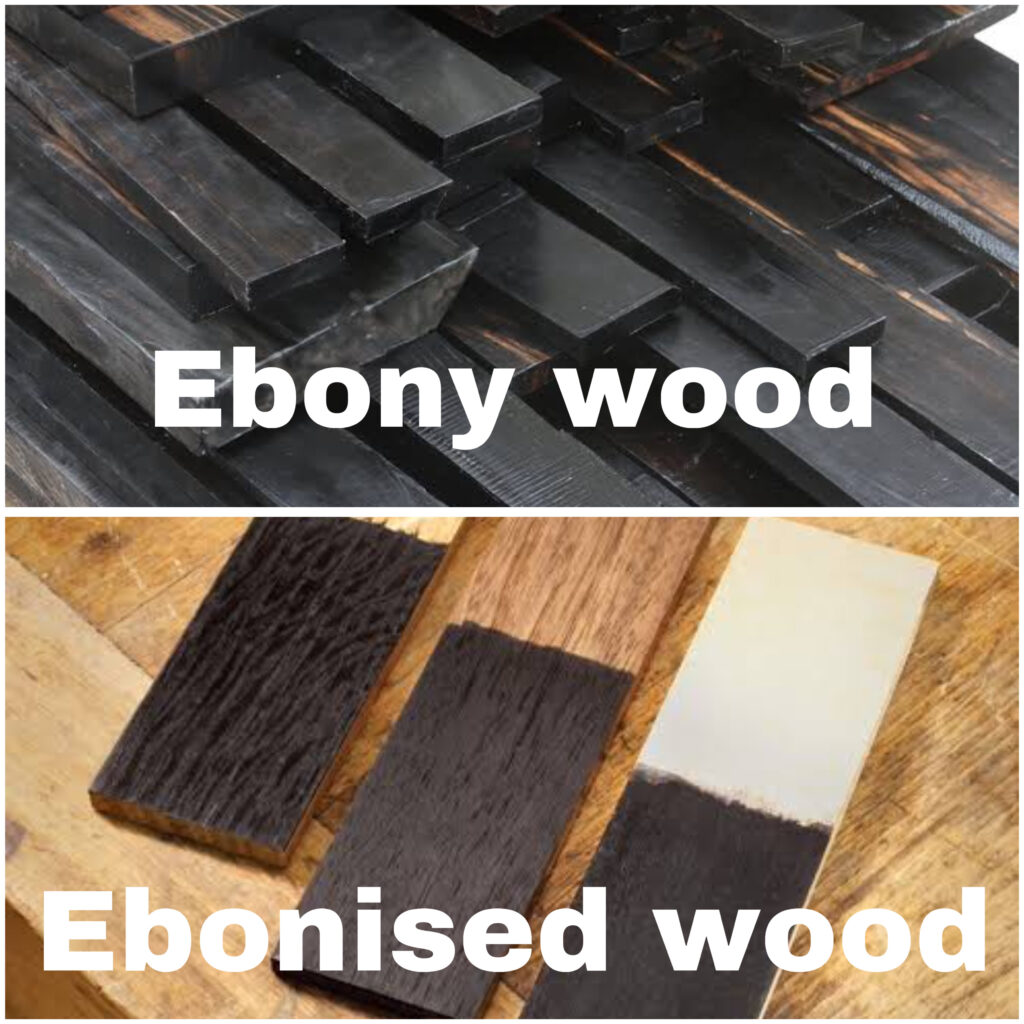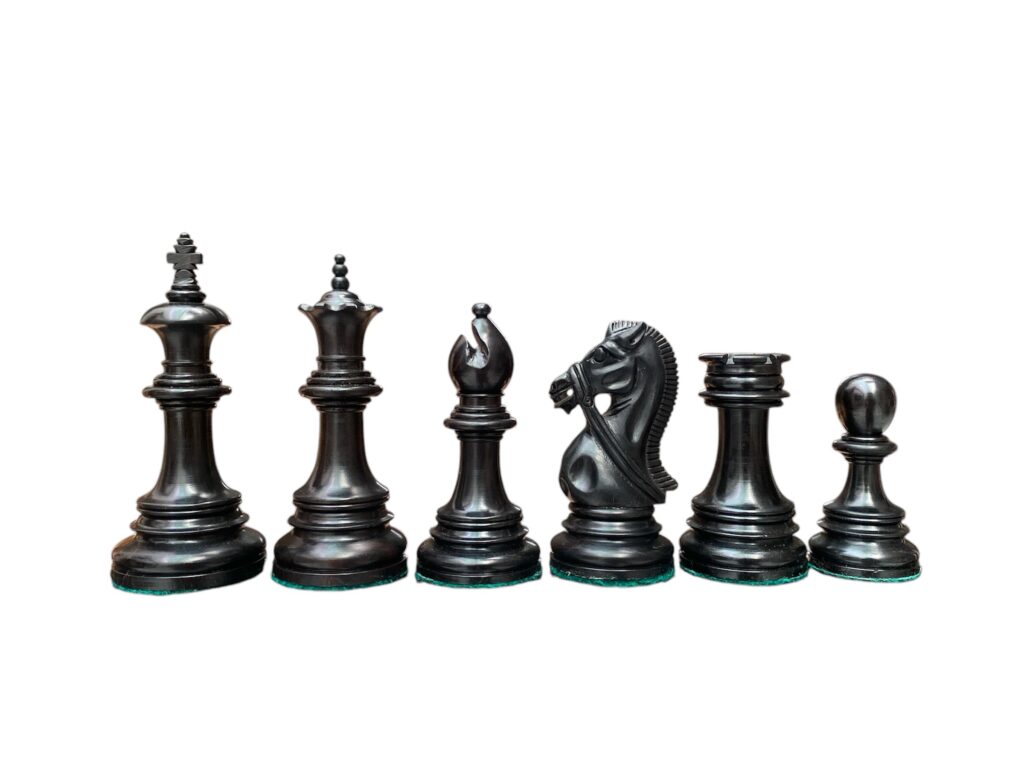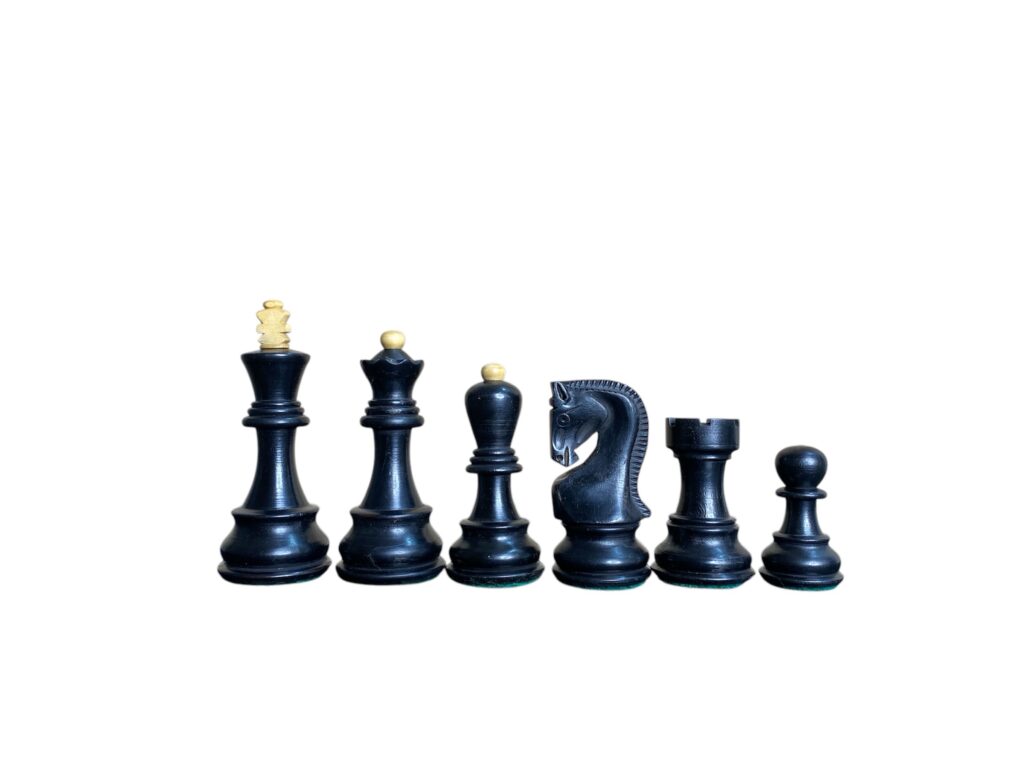Flat 30% OFF Use Code FLAT30
Flat 15% OFF Use Code STORE15
Flat 40% OFF Use Code FLAT40
COD Available
Flat 30% OFF Use Code FLAT30
Flat 15% OFF Use Code STORE15
Flat 40% OFF Use Code FLAT40
COD Available

The selection of materials for chess pieces plays a critical role in both the aesthetic appeal and functional performance of the game. When players and collectors consider the design of chess pieces, they often seek a harmonious balance between beauty and utility. Among various materials, ebonised wood and ebony wood have emerged as two of the most sought-after options. Their distinctive characteristics and visual allure make them highly valued by chess enthusiasts.
Ebonised wood, a material created by staining lighter woods to achieve a dark finish, not only mimics the luxurious appearance of ebony but also offers an economical alternative. This type of wood presents a striking visual contrast, especially when combined with lighter pieces made from contrasting materials. Its durability and performance are widely regarded, making it a practical choice for both casual play and serious competitions. The rich, dark hue of ebonised wood enhances the overall aesthetic of the chess set, creating an impression of sophistication. Furthermore, it allows for customization, enabling manufacturers to create unique designs that cater to individual tastes.
On the other hand, ebony wood is a naturally occurring substance valued for its density and rich, dark coloration. The appeal of ebony lies in its inherent beauty and structural integrity. It is often selected for premium chess sets due to its weight and luscious finish, which contribute to an overall sense of quality and craftsmanship. While the costs associated with ebony wood can be significantly higher than those for ebonised wood, many enthusiasts consider it a worthwhile investment for its unique properties and heritage.
As we explore the differences between ebonised wood and ebony wood chess pieces, it becomes evident that both materials offer unique advantages. Choosing between the two depends largely on personal preferences regarding aesthetics, budget, and intended use.

Ebony wood, renowned for its deep, rich coloration and tight grain, is a hardwood derived primarily from the genus Diospyros. This tree species is predominantly found in tropical regions, notably in Africa, Asia, and parts of Central America. One of the most sought-after varieties is Gabon ebony, originating from West Africa, which is particularly prized for its dense black hue and smooth texture. The wood is characterized by a fine, even grain, which often features subtle streaks of brown or gray, further enhancing its visual appeal.
One of the remarkable properties of ebony wood is its weight; this type of wood is notably dense, often making it heavier than many other hardwoods. This density not only contributes to its durability but also provides an impressive heft to chess pieces, which is vital for stability during play. Ebony’s exceptional hardness ensures that it withstands the rigors of use over time while retaining its aesthetic allure. Its natural oily composition enhances its luster, making ebony a preferred material for luxury items and fine art, including chess pieces.
The rarity of ebony wood significantly contributes to its high value in the market. As overharvesting and habitat loss have reduced the number of mature ebony trees, it has become increasingly difficult to source this material sustainably. Consequently, the demand for genuine ebony wood, especially in the realm of chess piece manufacturing, has risen, making quality ebony chess sets highly coveted among enthusiasts. The inherent beauty and unique characteristics of ebony wood not only elevate the craftsmanship of chess pieces but also ensure that they remain cherished collectibles for generations.

Ebonised wood is a term used to describe wood that has been treated to achieve a dark, ebony-like color, which mimics the appearance of natural ebony wood. The process of ebonising involves applying a stain or finish to lighter varieties of wood, converting their hue to a dark ebony shade. Common woods that undergo this transformation include oak, beech, and maple, as they are readily available and typically more affordable than genuine ebony. One of the primary techniques used for ebonising wood is to treat it with an iron acetate solution, which reacts with the natural tannins present in the wood. This results in a rich black coloration that can enhance the aesthetic appeal of the final product.
In addition to staining, other techniques may be employed in the ebonising process to achieve a specific finish. For instance, achieving a glossy surface often requires sanding and polishing, while ensuring a protective topcoat is applied adds durability. This treatment not only imparts the visual qualities of ebony but also makes the wood more resistant to wear and tear, which is particularly beneficial in the manufacture of chess pieces that are frequently handled. Ebonised wood offers benefits such as lightweight and stability, making it an excellent choice for crafting chess sets that are both attractive and functional.
Furthermore, ebonised wood can provide a sustainable alternative to natural ebony when created from responsibly sourced materials. As concerns over the environmental impact of high demand for exotic woods grow, many artisans and manufacturers have begun emphasizing the use of ebonised wood to create a visually similar yet more accessible option for chess enthusiasts and collectors. The balance between aesthetics and practicality presents ebonised wood as a viable choice in the world of chess pieces.
The distinction between ebonised wood and ebony wood is essential for chess enthusiasts when selecting pieces for gameplay. Both materials have unique qualities that cater to different preferences and budgetary considerations. Ebonised wood, primarily constructed from lighter woods and treated with a dark finish, is often more affordable compared to its solid ebony counterpart, which is a rare hardwood known for its rich, dark coloration and luxurious feel.
Appearance plays a significant role in the decision-making process. Ebonised wood products can mimic the aesthetic appeal of ebony wood closely; however, the depth and texture of true ebony are unparalleled. The solid wood has a natural grain that adds character and sophistication to chess pieces, while ebonised wood, despite its darker hue, may lack the same depth and intrinsic beauty. This factor is particularly important for collectors or those who appreciate the finer details in their chess sets.
Durability is another critical aspect to consider. Ebony wood is renowned for its density and resilience, making it a long-lasting option for chess pieces that can withstand frequent use. Ebonised wood, while relatively durable, may experience wear over time, especially if the finish starts to chip or fade. Maintenance requirements also differ between the two materials. Ebony wood typically requires periodic polishing and careful handling to preserve its natural beauty, while ebonised wood can be easier to maintain with simple cleaning methods. However, the longevity of ebonised wood pieces may not match that of solid ebony.
In conclusion, the choice between ebonised wood and ebony wood largely depends on individual preferences regarding budget, appearance, durability, and maintenance. Evaluating these factors can help players and collectors make informed decisions about their chess piece selection.
When it comes to selecting between ebonised wood and ebony wood chess pieces, your decision largely hinges on individual player preferences and circumstances. Various factors must be taken into account to ensure that the final choice aligns with both aesthetic desires and practical needs.
One primary consideration is your budget. Ebonised wood chess pieces typically offer a more affordable option compared to their ebony counterparts. Ebonised pieces, often made from lighter woods that have been stained to resemble ebony, can provide similar visual appeal at a fraction of the cost. For new players or those on a tight budget, ebonised wood may present the most sensible solution, as it allows for the enjoyment of a fine chess set without exorbitant expenses.
Aesthetic preferences also play a crucial role in this decision. Ebony wood is renowned for its rich, deep color and unique grain patterns, making it a stunning complement to any chess collection. If visual elegance, craftsmanship, and a luxurious feel are top priorities, investing in a set of ebony wood chess pieces could prove more satisfying in the long run.
Usage frequency should also influence your choice. If the chess pieces are primarily intended for regular, vigorous gameplay, ebonised wood might better withstand the rigors of frequent use while retaining their appearance. Alternatively, if the pieces are for display or special occasions, the enduring beauty of ebony could justify their purchase despite the higher cost.
Ultimately, choosing between ebonised wood and ebony wood chess pieces involves weighing budget constraints, aesthetic values, and practical requirements. An informed decision will enhance your enjoyment and investment in the game of chess.
When it comes to premium chess pieces, Boss Handicraft stands out as a reputable manufacturer known for its exceptional craftsmanship in producing both ebonised wood and ebony wood chess pieces. Established with a vision to create finely detailed and aesthetically pleasing chess sets, Boss Handicraft utilizes high-quality materials and traditional techniques that have been passed down through generations. Their commitment to excellence is evident in every piece they produce.
One of the defining features of Boss Handicraft’s offerings is the meticulous attention to detail. Each chess piece is crafted with precision, ensuring that the design reflects not only classical aesthetics but also modern sensibilities. The artisans at Boss Handicraft invest significant time and effort into carving, shaping, and finishing each piece, resulting in a product that appeals to both casual players and serious collectors alike. Remarkably, whether made from ebonised wood or natural ebony, the pieces exhibit a beautiful finish that enhances the inherent qualities of the wood.
Furthermore, Boss Handicraft employs a combination of traditional woodworking techniques and modern technology, allowing them to maintain high standards of quality throughout the production process. The balance and weight of each chess piece are carefully considered, ensuring a satisfying tactile experience during gameplay. Additionally, the brand prioritizes sustainability, sourcing their woods responsibly to contribute to ecological conservation efforts.
Ultimately, choosing chess pieces from Boss Handicraft means investing in a blend of artistry and utility. The dedication to fine craftsmanship and quality assurance ensures that each chess set is not just a game but a lifelong companion for enthusiasts. As you consider whether to opt for ebonised wood or ebony wood chess pieces, the heritage and dedication of Boss Handicraft should undoubtedly influence your choice.
In the world of chess, player preferences can greatly vary based on personal experiences with different materials used in their chess pieces. An avid chess player named Robert, who has been competing for over a decade, shares his thoughts on ebonised wood versus ebony. He states, “When I first started playing, I was drawn to the sleek appearance of ebonised wood chess pieces. They have a modern aesthetic that truly enhances the visual appeal of the board. However, upon trying ebony pieces, I was captivated by their rich, natural finish. They feel sturdier and offer a classic presence during gameplay.”
Another enthusiastic chess player, Emma, compares the performance aspects of both types of pieces. “Although my first set was ebonised wood, transitioning to ebony was an eye-opener,” she mentions. “The weight distribution and overall craftsmanship of ebony pieces are exceptional. I appreciate how each piece feels balanced in my hand, contributing to a more enjoyable playing experience.” Emma’s sentiments highlight how the tactile feel of the chess pieces can influence gameplay, something that many players might overlook.
Lastly, a frequent tournament participant, James, elaborates on the longevity aspect of both variations. He notes, “Ebonised wood certainly has its appeal, particularly for those who prefer a less formal look, but I have found that ebony pieces, with proper care, last significantly longer. They don’t chip or wear as easily. For someone invested in chess, the choice boils down to whether aesthetic or durability is more important.”
The testimonies from these chess enthusiasts underscore the diverse experiences available with both ebonised wood and ebony wood chess pieces. While aesthetics, performance, and durability vary among players, these qualities ultimately help individuals determine which type aligns more closely with their personal preferences in the game of chess.
When it comes to purchasing Ebonised and Ebony wood chess pieces, choosing a reputable retailer is essential for ensuring quality and authenticity. One of the most recommended outlets for acquiring these finely crafted chess pieces is Boss Handicraft. This retailer specializes in high-quality chess sets made from various materials, including both ebonised and authentic ebony wood. Their extensive collection caters to both casual players and collectors, making it a reliable source for anyone seeking beautiful and durable pieces.
While exploring the options at Boss Handicraft, potential buyers should keep a few key factors in mind. First, consider the type of chess pieces that will best suit your needs. Ebonised pieces are often more affordable and offer a similar aesthetic appeal to ebony wood, but they may not carry the same weight or depth of color as genuine ebony. Conversely, ebony pieces provide a luxurious feel and exceptional durability, attracting avid chess enthusiasts and collectors, but at a higher price point.
Additionally, pay attention to the craftsmanship of the chess pieces. Look for detailed descriptions and images that showcase the carving and finishing processes, as well as any unique features that may be included. Before making a purchase, it is wise to read customer reviews and assess their experiences with the quality and delivery services of the retailer.
In summary, for high-quality ebonised and ebony wood chess pieces, Boss Handicraft stands out as an ideal choice. By considering factors such as material, craftsmanship, and customer feedback, buyers can make informed decisions that cater to their personal preferences and budget constraints.
Choosing between ebonised wood and ebony wood chess pieces is a decision that extends beyond mere aesthetics; it involves understanding the unique properties of each material and how they align with one’s personal preferences and playing style. Ebonised wood, often more affordable and widely available, provides a stunning appearance that closely resembles the rich, dark hues of genuine ebony wood. However, it is essential to recognize that this synthetic alternative may not exhibit the same longevity or tactile warmth that one might find with authentic ebony pieces. On the other hand, ebony wood is undoubtedly prized for its exquisite density and remarkable durability, making it a superb choice for serious chess enthusiasts and collectors alike.
Moreover, the quest for the ideal chess piece often reflects individual tastes and values. Some players may prioritize sustainability, gravitating towards ebonised wood options to minimize their ecological footprint. Others may appreciate the traditional craftsmanship and unique characteristics of genuine ebony, finding joy in owning a piece that has been crafted from this esteemed material. When selecting chess pieces, consider factors such as your budget, how often you play, and whether you view chess purely as a casual pastime or a competitive engagement.
The interplay between personal preference and the qualities of the materials discussed ultimately shapes your chess experience. By thoroughly evaluating your options, you not only enhance your enjoyment of the game but also invest in chess pieces that resonate with your aesthetic sensibilities. Whichever path you choose, ensuring that your chess pieces align with your preferences will create a richer and more satisfying playing experience, enhancing both enjoyment and strategy on the board.